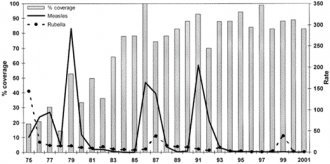
Nationwide Health and aged care services Costa Rica
 Percentage of 1‐year‐old kids vaccinated with connected measles‐rubella vaccine and reported incidence of measles and rubella, Costa Rica, 1975–2001. Data from Ministry of wellness, Department of Statistics and Epidemiology, Costa Rica.
Percentage of 1‐year‐old kids vaccinated with connected measles‐rubella vaccine and reported incidence of measles and rubella, Costa Rica, 1975–2001. Data from Ministry of wellness, Department of Statistics and Epidemiology, Costa Rica.
Figure 1.
Portion of 1‐year‐old young ones vaccinated with mixed measles‐rubella vaccine and reported incidence of measles and rubella, Costa Rica, 1975–2001. Data from Ministry of wellness, Department of Statistics and Epidemiology, Costa Rica.
The epidemiology of measles and rubella remained mainly unchanged for the 1970s because of reasonable vaccination coverage (7000 cases reported). The latter outbreak occurred primarily in densely populated places, primarily impacted children 40 yrs . old taken into account 51.1% of donations before the campaign and 95percent during and immediately after the promotion.
Surveillance. Surveillance of febrile exanthematic diseases is integrated in Costa Rica. It's based on neighborhood recognition, immediate notice, and investigation of suspected situations of rash and temperature. All health services, general public and exclusive, must report suspected instances into local and central level of health insurance and initiate situation investigation straight away. A blood test is gathered and provided for the National Reference Laboratory (INCIENSA) to be tested for rubella, measles, leptospirosis, dengue, and Hantavirus, depending on epidemiologic and clinical information. During 1999–2001, 3056 blood examples were tested for measles IgM and 3463 for rubella IgM (dining table 2). Just 4 (0.13per cent) of 3056 samples tested for measles IgM were confirmed as measles situations; 92 samples with clinical analysis of measles had been IgM good for rubella and 40 examples had been IgM positive for dengue. Surveillance for measles and rubella in Costa Rica has actually enhanced since surveillance protocols were updated, diagnostic capabilities had been enhanced to separate and identify virus, and education programs were created for staff on national epidemiologic surveillance center.
Dining Table 2.
Number of suspected measles and rubella reported instances, quantity tested, and percentage of verified cases tested, Costa Rica, 1999–2001.
Table 2.
Conversation
The epidemiology of rubella and measles in Costa Rica reflects the immunization program implemented over three decades ago. As a result of reduced protection of both rubella and measles antigen vaccines within the 1970s and early 1980s, outbreaks proceeded to occur; however, within the mid‐to‐late 1980s and very early 1990s, a shift in susceptibility to your older age brackets had been recorded. Since the mid‐1990s, Costa Rica implemented the strategies suggested to eradicate measles. Routine vaccine distribution, including follow‐up for defaulters and outreach activities, assisted attain high MMR vaccine coverage. Nationwide vaccination campaigns focusing on all age cohorts 80percent was not achieved until 12 years following the introduction of rubella‐containing vaccine. In Costa Rica, the rubella virus blood circulation probably did decrease so individuals that would typically be contaminated (those neither vaccinated nor contaminated during childhood) remained vulnerable at adulthood. During the last 2 decades, a few nations have actually introduced vaccination strategies offering childhood programs and also the targeting of teenage women and/or women of childbearing age [11]. This process reduces the blood circulation of rubella virus and safeguards the high‐risk team.
To reduce the risk of CRS, Costa Rica conducted the very first person male and feminine MR promotion in Latin America. Than childhood mass promotions, person campaigns can be more challenging. The Costa Rica knowledge strengthened the necessity of identifying the goal populace, applying social mobilization, guaranteeing commitment for the governmental and clinical communities, tabs on development during the promotion, and ensuring a nation blood circulation.
Problems associated with focusing on a grown-up populace (age.g., large flexibility and poor curiosity about vaccination programs) had been taken into account for planning reasons. Making use of different strategies for outlying and towns adjusted to each specific situation at different phases of this campaign execution proved efficient. In remote rural areas, tasks should begin within periphery and advance toward the absolute most populated facilities. In urban areas, they ought to begin at places of work and training and end with door‐to‐door mop up. In areas with immigrants, vaccination groups should-be trained to vaccinate all individuals in the target generation despite nationality or immigration standing.
Personal mobilization tasks were necessary for the success of the promotion. Strategies were directed into medical care employees and populations. Various innovative tasks created during the campaign encouraged the involvement of hospitals, the community, and training and private areas. Also, the active involvement of healthcare workers as well as the participation of medical communities among others professions proved invaluable.
The growth and use of progress signs during campaign assisted in the reformulation of methods together with success of objectives. For this end, the availability of timely limited progress reports ended up being important to determine and resolve problems during the promotion. Sketches mapping coverage by canton and quick track of coverage in convenience examples of dwellings and workplaces complementing the official registry facilitated the recognition of unvaccinated teams.
To prevent a blood shortage, close collaboration between the nationwide authorities in control of planning and track of the campaign and blood finance companies should take place. Donors >40 yrs old, have been not targeted when you look at the campaign, maintained the bloodstream reserves. Other strategies to avoid blood shortages should be thought about throughout the preparation phase of a vaccination promotion for adults including conducting a blood drive before the vaccination promotion to construct reserves, choosing a pool of donors to be immunized after the promotion, and offering bonuses for blood contribution among individuals elderly 40–60 many years during campaign.
By setting up a target of accelerated rubella and CRS prevention, Costa Rica strengthened measles eradication. Lots of the crucial components for attaining accelerated rubella control and CRS prevention are fundamental facets for measles elimination (age.g., large routine immunization protection, across the country vaccination promotions focusing on all age cohorts













